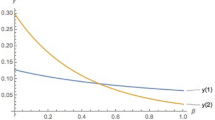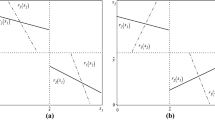Abstract
We consider a model in which firms first choose process R&D expenditures and then compete in an output market. We show the symmetric equilibrium under R&D competition is sometimes unstable, in which case two asymmetric equilibria must also exist. For the latter, we find, in contrast to the literature that total profits are sometimes higher with R&D competition than with research joint venture cartelization (due to the cost asymmetry of the resulting duopoly in the noncooperative case). Furthermore, these equilibria provide another instance of R&D-induced firm heterogeneity.
Similar content being viewed by others
References
Amir, R. (1997): “Modelling Imperfectly Appropriable R&D via Spillovers.” Mimeo, Odense University, Odense, Denmark.
Amir, R., and Lambson, V. E. (1997): “On the Effects of Entry in Cournot Markets,” Mimeo, Odense University, Odense, Denmark.
Amir, R., and Wooders, J. (1997a): “Effects of One-Way Spillovers on Market Shares, Industry Price, Welfare and R&D Cooperation.” University of Arizona Discussion Paper 97-1, Tucson, AZ.
Amir, R., (1997b): “One-Way Spillovers, Endogenous Innovator/Imitator Roles and Research Joint Ventures.” University of Arizona Discussion Paper 97-2, Tucson, AZ.
d'Aspremont, C., and Jacquemin, A. (1988): “Cooperative and Noncooperative R&D in Duopoly with Spillovers.”American Economic Review 78: 1133–1137.
— (1990): “Erratum.”American Economic Review 80: 641–642.
Brander, J., and Spencer, B. (1983): “Strategic Commitment with R&D: the Symmetric Case.”Bell Journal of Economics 14: 225–235.
Cox, J., and Walker, M. (1997): “Learning to Play Cournot Duopoly Strategies.”Journal of Economic Behavior and Organization (forthcoming).
Henriques, I. (1990): “Cooperative and Noncooperative R&D in Duopoly with Spillovers: Comment.”American Economic Review 80: 638–640.
Holt, C. (1995): “Industrial Organization: a Survey of the Results of Laboratory Experiments.” InHandbook of Experimental Economics, edited by A. Roth and J. Kagel. Princeton: Princeton University Press.
Kamien, M., Muller, E., and Zang, I. (1992): “Research Joint Ventures and R&D Cartels.”American Economic Review 82: 1293–1306.
Kandori, M., Mailath, G., and Rob, R. (1993): “Learning, Mutation and Long-Run Equilibria in Games.”Econometrica 61: 21–56.
Katz, M. (1986): “An Analysis of Cooperative Research and Development.”Rand Journal of Economics 17: 527–543.
Kohlberg, E., and Mertens, J. (1986): “On the Strategic Stability of Equilibria.”Econometrica 54: 1003–1037.
Milgrom, P., and Roberts, J. (1991): “Adaptive and Sophisticated Learning in Repeated Normal-Form Games.”Games and Economic Behavior 3: 82–100.
Salant, S., and Shaffer, G. (1992): “Optimal Asymmetric Strategies in Research Joint Ventures: a Comment on the Literature.” Mimeo, University of Michigan, Ann Arbor, MI.
Seade, J. (1980): “On the Effects of Entry.”Econometrica 48: 479–489.
Author information
Authors and Affiliations
Rights and permissions
About this article
Cite this article
Amir, R., Wooders, J. Cooperation vs. competition in R&D: The role of stability of equilibrium. Zeitschr. f. Nationalökonomie 67, 63–73 (1998). https://doi.org/10.1007/BF01227763
Received:
Revised:
Issue Date:
DOI: https://doi.org/10.1007/BF01227763




